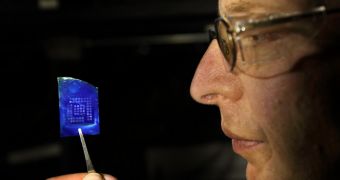A group of investigators at the Sandia National Laboratories (SNL), led by material scientist Alec Talin, announces the development of a technique that enables scientists to boost the electrical conductivity of a particular type of metal-organic framework (MOF) by more than six orders of magnitude.
Achieving electrical conductivity in MOF is one of the long-term goals of electrical engineers and materials scientists, primarily because these materials are especially well suited for a wide variety of applications, in developing new sensors, energy conversion and storage, and in creating new electronics.
Details of the new approach were published in a paper entitled Tunable Electrical Conductivity in Metal-Organic Framework Thin-Film Devices, which was published in the December 5 early online issue of the journal Science Express.
The work was conducted by scientists at SNL and colleagues from the US National Institute of Standards and Technology (NIST). Talin was the lead author of the new paper, and one of the researchers responsible for developing the new technique.
“Fundamentally, this sheds enormous light on the conduction process in these materials,” he says. Colleague Mark Allendorf, who is a senior scientist at SNL, says that the improved MOF could be used in new microelectronics, energy-harvesting device, medical diagnostics applications, and sensing.
“When you imagine the ‘Tinkertoys’ we played with as children, you recall they are essentially wooden balls with holes that you can link together with sticks. MOFs work the same way, only you substitute metal ions for the balls and organic molecules for the sticks,” says Allendorf, who adds that these MOF are the most exciting thing he has ever worked on in 28 years at Sandia.
The unusual combination of properties that characterizes MOF derives from a unique combination of organic and inorganic components. Some of their most interesting traits include a very large surface area, which stems from another property, called nanoscale porosity. MOF have excellent thermal stability, too.
“Importantly, MOFs possess a characteristic of molecules that allows us to adapt their properties to a specific application: we can perform chemistry on them, unlike traditional inorganic electronic materials, such as silicon and copper,” Talin says.
“This isn’t like silicon, which can’t change its electrical properties,” Talin said. “You can add tiny amounts of dopants to silicon or introduce other impurities, but with our approach, you suddenly have the potential to tailor the material to achieve exactly the properties you want. This is the beauty of molecular electronics,” the expert concludes.

 14 DAY TRIAL //
14 DAY TRIAL //